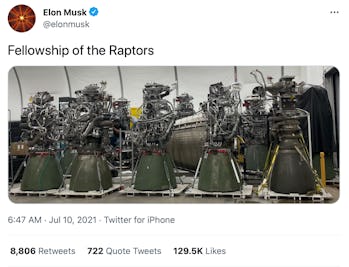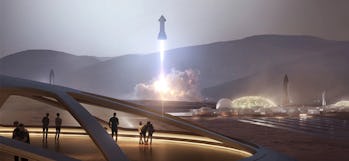HOW MANY ROCKET ENGINES does it take to build a city on Mars? Somewhere around 9,000 per year, according to Elon Musk.
On July 10, the SpaceX CEO outlined on Twitter how his company plans to increase production of the Raptor.
The rocket engine is designed for use with the Starship, a fully-reusable stainless steel ship intended to send the first humans to Mars.
In response to a question about how many Raptors SpaceX aims to produce per year, Musk tweeted:
“Roughly 800 to 1000 per year. That’s about what’s needed over ten years to create the fleet to build a self-sustaining city on Mars. City itself probably takes roughly 20 years, so hopefully it is built by ~2050.”
The response shows how Musk is planning to schedule out production, with an end goal of producing enough ships to build a self-sustaining city on Mars by 2050. Although SpaceX has yet to send a single human to Mars, the CEO’s figures reveal how he plans to meet his self-declared goal of sending one million tons of cargo to the planet — which he claims could be enough for the city to live without Earth’s support.
SPACEX STARSHIP: HOW IT POWERS MARS MISSIONS
The Starship is a fully-reusable rocket designed to send over 100 tons or 100 people into space at a time. The vehicle is comprised of two parts: a ship, also called Starship, and a booster called Super Heavy. The booster is used to give the ship the necessary power to leave the Earth.
The Starship’s predecessor, “BFR,” was first unveiled in 2017. It’s designed to cover SpaceX’s current crew and cargo launches undertaken by the Falcon 9 and Falcon Heavy, while also enabling more ambitious missions like sending people to Mars.
Beyond offering sheer power, the ship is also useful for Mars missions because of its fuel. The Raptor engines are powered by liquid oxygen and methane, unlike the rocket propellant used by the Merlin engines in the Falcon 9. The fuel is intended to enable astronauts to land on Mars and refuel using the planet’s resources.

Each Starship will require a lot of Raptor engines. On Sunday, Musk confirmed on Twitter that the team has decided the booster will use 33 engines to offer 500,000 pounds of sea-level thrust. These engines will all be the same, except for the outer 20 which will lack some of the more complex controls.
The ship itself is expected to use a further six engines. That means, in total, each Starship and Super Heavy pairing will use 39 engines.
SPACEX STARSHIP: HOW MORE SHIPS ENABLE A MARS CITY
Musk wants to build 800 to 1,000 Raptor engines per year. That would be enough engines for 20 to 25 booster-equipped Starships per year. Over a 10-year period, SpaceX could build a Starship fleet of up to 256 booster-equipped vehicles.

But there’s a catch: the ship won’t need the booster once it leaves Earth. Indeed, Musk plans to return the booster to Earth so it’s “ready to refly in under an hour.”
It’s unclear how many Super Heavy boosters SpaceX plans to produce. If SpaceX builds 1,000 Raptors in a given year and uses them all on the ship portion of the Starship, that would be more like 166 ships per year. That’s 1,660 ships over the 10-year period.
Mars is a long way from Earth, on average 140 million miles away, but SpaceX claims on its website that it can use each Starship to send 100 tons of cargo all the way to the red planet. It plans to use on-orbit refueling in low-Earth orbit, once the ship has left the Earth, to add enough fuel to complete the journey.
In 2019, Musk also noted that a self-sustaining city on Mars would likely require somewhere in the region of one million tons of cargo. That requires around 10,000 Starship launches to reach that figure.
Musk also claimed that each Starship will be designed to fly three times per day, which means around 1,000 launches per year. Of course, flying to Mars and back will take several months, so these launches will be likely for closer low-Earth orbit missions.
Hosting 10,000 launches with 250 vehicles would mean that each ship has to fly 40 times. That would require each ship to complete the round trip from Mars and back in the space of six months.
As the trip to Mars could take anywhere between 80 to 150 days, and Mars reaches its closest point with Earth around once every 26 months, a six-month turnaround is a little too tight.
But in the best-case scenario, if SpaceX manages to build 166 ships per year, each ship only has to launch six times over the 20-year period to meet Musk’s cargo transport goals.
For what it’s worth, Musk claimed in 2019 that SpaceX could build its city over the course of 10 orbital synchronizations with Mars. Get ready for a giant fleet of Starship launches every 26 months.
It’s hard to say how many ships SpaceX will actually produce, whether it will meet these production goals, and whether timings will slip. But in these figures, a picture emerges of how Musk plans to meet his goal of a city by 2050.


